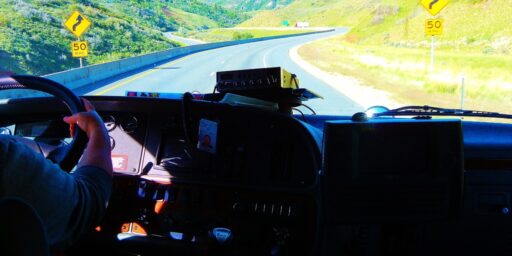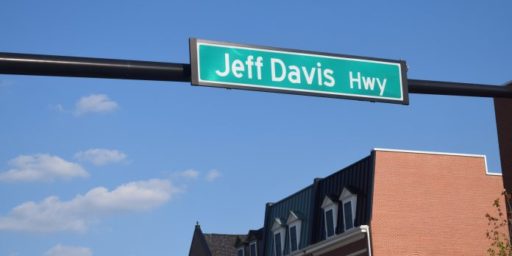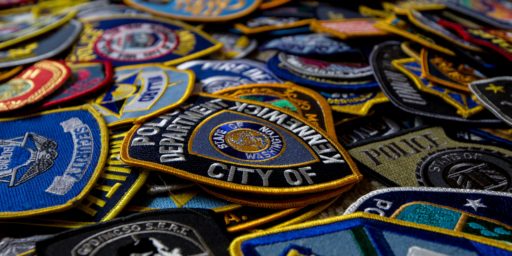Speed Kills?
The Washington Examiner editorial board (now under the direction of Mark Tapscott) points to Virginia Tech Transportation Institute study which found that eighty percent of vehicular crashes occur when drivers are “distracted by things like talking on cell phones, applying makeup and consuming fast food.” This study certainly comports with my personal observations; indeed, it seems that almost all the drivers I witness making stupid mistakes are yapping on the phone.
The Examiner argues that the study, embraced by the National Highway Traffic Safety Administration, should provide a wake-up call for those in charge of highway safety.
The most obvious starting point for that rethinking is the priorities that govern how state troopers and local police in Maryland, the District of Columbia and Virginia approach traffic safety. For decades, their work has been governed by the conventional wisdom that excessive speed is the biggest threat to safe travel on area roads and should thus be the primary focus of traffic enforcement. That speed enforcement also provides a steady revenue stream for local and state governments has encouraged a disproportionate focus on catching speeders.
The NHTSA/VTTI study demonstrates the flaw in this traditional emphasis on speed enforcement. Instead of sitting beside the road, radar gun in hand waiting to snare morning commuters who dare to go 72 mph instead of 55 mph, troopers and patrol officers should be actually cruising in traffic looking for distracted drivers. Spending more time in traffic would have the ancillary benefit of increasing enforcement visibility, which is a factor long thought to be among the most important in encouraging compliance with traffic laws.
I have long thought that patroling the roads was a better use of Troopers. Indeed, I would much prefer to see them looking out for Left Lane Bandits (people going 10 mph below the speed limit yet insisting on staying in the passing lane–often while on a cell phone), reckless drivers, and the like.
The problem, however, is that traffic law enforcement long ago ceased to be motivated primarily by public safety. The point of radar guns, red light cameras, and all the rest is revenue generation. Given that those ticketed with speeding almost always just mail in their ever-heftier fines, sitting by the roadside with a radar gun is simply a more efficient use of the officers’ time from a revenue maximization standpoint. Discovering distracted drivers and then proving that they were indeed distracted in a court of law would be much more difficult.
There are implications in the study for automakers, too. Those multi-button instrument panels that require drivers to take their eyes off the road simply to change stations on the stereo are clearly a significant safety problem. Ditto on the proliferation of satellite navigation screens, power points for laptops and plug-ins for iPods.
Quite right. Many vehicles now put sound system controls and the like on the steering wheel, an innovation that should be adopted industry wide. But navigation systems and a proliferation of entertainment options are likely to stay with us and, indeed, be more common as they move from luxury add-ons to standard features. Perhaps something along the lines of a heads-up display, common in aircraft and other military systems, could be adopted for private transportation.






“Perhaps something along the lines of a heads-up display, common in aircraft and other military systems, could be adopted for private transportation.”
Some vehicles, like the Cadillac STS already have HUDs in their system, and there are places where you can buy them to add into an existing vehicle. This is pretty new still, but it’s spreading.
If the government or law enforcement won’t take the lead, then the insurance industry should. One of the ideas that was brought up was to install cameras in all cars to monitor driver behavior. If the cameras capture the driver being inattentive before an accident occurs, then the insurance company can decline coverage for the accident. Hit them in the pocketbooks.
DCL: Yikes, I’d hate to see insurance companies get that type of power.
Going after Left Lane Bandits actually gets closer to the real “speed kills” issue. Excessive speed does not kill. Just like any airline catastrophe, accidents are a confluence of (mis)events. When you combine excessive speed with large speed differentiations (ie a Left Lane Bandit going 45, and a Just Got My License Mario going 72 and passing the Bandit on the right), you’ve got a recipe for disaster.
While so-called “left lane bandits” drive me up the wall like most people, I cannot see how they are violating the law. In most places, I see a maximum speed limit of 65 or 70 (on 395 it is 55), but I do not see a “minimum speed limit” sign in many states. Even so, the minimum speed limit is 40 or 45mph, so as long as someone is doing that technically they are not really violating the law, are they?
As far as cameras in the car: no. way. What would be next? Giving them the power to install speed regulators so you cannot go above a certain speed?
I’m all for personal responsibility. People who engage in high risk behavior should pay more than people who do not engage in those behaviors. Otherwise let’s just have no fault insurance.
While so-called �left lane bandits� drive me up the wall like most people, I cannot see how they are violating the law.
Several states have laws requiring that freeway traffic stay to the right unless passing. Chalk me up as another person that’s driven absolutely insane by left lane bandits.
america’s roads are as safe as possible with human driver’s. the risk to drive on our highways, is accepable and to a huge extent controlable with good training and due diligence.there are more than adequate controls[laws and penalties], and in general the road designs are excellent.no matter what new measures are passed, there will always be bad drivers doing stupid things. their behaviors, for the most part have never been the focus of enforcement. also don’t forget; even good drivers make bad mistakes. if you are afraid of traffic, then either improve your skills or stay off the road, because it’s about as safe as it ever will be out there. please no more expansion of bureaucratic style “safety ideas”.
That’s odd, because when drivers around me are making stupid mistakes, I’m too busy trying to stay out of the accident to notice whether they’re on the phone. ;-p
Anyway, most of the drivers I see making stupid mistakes are stupid. Having a cell phone is optional.
One of the research papers I did for my Master’s — I believe in the summer of 2001 — found that cellphone usage caused less than 2% of distracted-driving accidents, and that “things going on outside the car” (ie: billboards, people on the side of the road) were #1 with about 18%.
Josh: But cell phones have proliferated since then. Now, it seems that everyone is on the phone all the time. Still, the studies that I’ve seen comport with what your findings were.